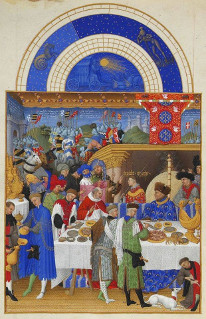Perugia Weaves
Creating Patterns for Perugia Weaves
This article addresses creating patterns for Perugia weaves. Specifics in weaving the patterns will not be addressed except where necessary to understand how the pattern will be used. These specifics are derived from personal experience and from The Compleat Anachronist #114 (Thorson 2002).
Beginning around the 14th century, fabrics misleadingly known as 'Perugia Weaves' appeared throughout Europe. In general the fabrics were woven with a diaper ground using white linen yarn and intermittently broken with stripes and/or brocaded patterns using a heavier weight cotton or linen yarn dyed with indigo or woad. There are some exceptions but are rare. Fabrics were mostly towels, runners and tablecloths though similar patterning has been noted in other uses such as veils.
Patterns
My belief is that that patterns were woven by the weaver using one of three methods: freehand, from a cartoon or, from a graphed 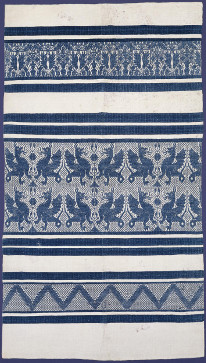 pattern. Patterns consisted of simple bands, repeated geometric figures, and in more elaborate examples, repeated images.
pattern. Patterns consisted of simple bands, repeated geometric figures, and in more elaborate examples, repeated images.
The extant towel in the image on the right is one example. In the top pattern frame is what appears to be an heraldic device in a field of embelishemts. In the center are facing gryphons and the bottom contains a geometric pattern. Gryphons seem to be commonly used but other figures such as bears, dragons, and in at least one case, mounted knights. Other examples are shown at the end of this article.
Image widths are generally narrow and repeated across the width of the fabric. This may be due to imposed limitations of drawlooms or printable patterns.
The graphed patterns included in the period books I have looked at (see Excerpts From Period Books below) have drafts that, when woven, would be between 1 1/2 to 4 inches in height and width and extant examples of Perugia weaves do appear to support this.
Graphed Patterns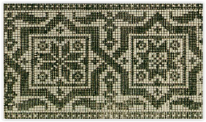
The earliest graphed patterns I have been able to find were printed in Germany in the 1500's though it is believed they were used long before this time. The primary reason given as to why we do not have any extant examples of these is because they were regularly used: pinned to the fabric or cut into strips (Speelberg, 2015). The published patterns were intended for various fiber arts including embroidering and weaving and modified as needed. The two images to the right were extracted from a book published by Johann Stiebemacher in 1597. I will be referring to these when discussing graphed patterns. As with the other images in this article, you can see a larger version by clicking on the image.
Taking a closer look at the images, you can note that the images are repeatable. Using the second image that has, what I think are facing dragons, the working pattern begins with the center of the 'flower' on the left and ends on the last graph column before the center of the 'flower' on the right.
The first image is differant in that the pattern not only repeats left to right, it is also a mirror image on the vertical axis.
Weft Floats
Before I go into the construction or design of graphed patterns, let me take a moment to discuss weft floats.
NOTE: discussion or mention of weft floats is strickly for understanding how they will be managed by the weaver. When creating a graphed pattern, the artist need not be overly concerned with float length.
When weaving, we pass weft yarns over and under warp yarns. In simplest terms, a weft float is created by weft yarns going over a certain number of warp yarns before transecting the plane of the fabric. The weft float length is the number warp yarns in the float. The shortest weft float (1) is what you see in plain weave. Weft float lengths are usually referred to by the number of warp threads passed over/under or by their measured length. The measured length can be deduced by the sett or number of warp threads in an inch of weaving width. So, with a sett of 32 (32 warp threads per inch), a weft float of 8 is 1/4" long.
The concern for the length of the weft float is that the longer the float, the less stable the fabric is. For towels, which are expected to take abuse, a weaver needs to try to keep floats 1/4" or shorter. Floats 1/2" are acceptable in other projects though you may see floats as long as 1-2" in delicate items like lace. For Perugia weaves, the weft floats should not exceed 1/4" or 8 warp threads.
Construction/Design of Graphed Patterns
Click on the graphed pattern to the right to see a larger version of it. While looking at it, keep in mind that this pattern would have been used by multiple types of fiber artists and interpreted as needed for their process. 
Each row of the graph row represents one pass of weft or pattern yarn.
Each column represents two warp threads. This means that if a series of darkened cells is three cells wide, the pattern yarn will go over six warp threads before transecting the plane of the fabric. This creates floats (see above) which we'll address more closely later.
Each cell in the graph, for Perugia weaves, represents approximately 1/18th of inch in height and width of the final woven product. A graph consisting of 18 rows and 18 columns will be 1" wide and 1" tall in the final product (approximate).
To weave a row of the graphed patterns, the weaver needs only to create a shed by picking up the threads noted in the blank (white) squares in the graph and the pass the weft or pattern yarn thru the shed.
Remember what I said about weft floats? For the Perugia weave, we need to limit the weft floats to 1/4". In the graph, four squares relate to 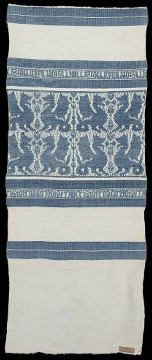 1/4" of weaving or 8 warp threads (Thorson, 2002). This means the maximum number of graph cells in a row that the weaver can use continuously is four cells. You'll notice in the graphed pattern, though, that there are several places where there are more than four darkened or blank cells in series on the same row. How the weaver handles this is with a slight trick. Remember that each cell represents two warp threads. The reason for two warp threads is to keep the float length even with the height. Also, keep in mind that the pattern thread is thicker than the warp thread. The slight trick is that the weaver periodically picks up or pushes down one warp thread to tie the float down. For instance if you have a series of five darkened cells in a row, the weaver would pick up one thread in the third cell creating two floats (one float of 5 and one float of 4). This creates some speckaling but keeps the weft float shorter. Click on the image to the right to see an example of this being done. It is difficult to see where this is done in the pattern because the thicker pattern yarn covers the thinner warp yarn.
1/4" of weaving or 8 warp threads (Thorson, 2002). This means the maximum number of graph cells in a row that the weaver can use continuously is four cells. You'll notice in the graphed pattern, though, that there are several places where there are more than four darkened or blank cells in series on the same row. How the weaver handles this is with a slight trick. Remember that each cell represents two warp threads. The reason for two warp threads is to keep the float length even with the height. Also, keep in mind that the pattern thread is thicker than the warp thread. The slight trick is that the weaver periodically picks up or pushes down one warp thread to tie the float down. For instance if you have a series of five darkened cells in a row, the weaver would pick up one thread in the third cell creating two floats (one float of 5 and one float of 4). This creates some speckaling but keeps the weft float shorter. Click on the image to the right to see an example of this being done. It is difficult to see where this is done in the pattern because the thicker pattern yarn covers the thinner warp yarn.
In the spreadsheet that you can download by clicking on the link just below, I've recreated the graphed pattern to show the required half heddles. In the spreadsheet, I've annoted the pattern squares with 'X's and highlighted them with a colored background to make the pattern more visible in a zoomed out view. I've also added '\' to note where I need to pick up or push down a warp thread. A suggestion for the artist would be to also use '\'s or half colored squares around the edges of their pattern to 'soften' the edges.
When creating a graphed pattern, the artist need not be overly concerned with float length. The weaver will be able to work around them. A method of avoiding the speckaled look is shown in the image at the beginning of this article. The slight trick noted above was used in a measured way to create the diamonds and keep the floats shorter. (note: advanced topic that I'm not ready to attempt :) )
To help with chart creation, I created a spreadsheet with cell resized and bordered that you might be able to print on transparency and then trace a pattern onto it. An 18:18 square on the graph is slight larger than 1 inch.
Graph Chart
Excerpts From Period Books
Following are exerpts from period books that contain patterns for embroidering, weaving, etc. These patterns were collected by the authors from various sources. Some art historians believe that some may have come from earlier sketchbooks (Speelberg, 2015). The patterns were reused and sometimes modified (ie gryphon replace with another figure).
Johann Siebemacher, 1597
(sourced from http://daten.digitale-sammlungen.de/~db/0002/bsb00026001/images/index.html?seite=00001&l=en)
Schön Neues Modelbuch von allerley lustigen Mödeln naczunehen, zuwürcken unn zusticken, gemacht im Jar Ch. 1597, Nurmberg, 1597
(for smaller file sizes, cover pages,some blank pages and scratch pages have been omitted)
Part 1
Part 2
Part 3
Part 4
Anton Woensam, 1536
(sourced from http://daten.digitale-sammlungen.de/~db/0008/bsb00083044/images/index.html?seite=00001&l=en)
Ein new kunstlich Modelbuch dair yn meir dan Sechshundert figurenn monster ader stalen befonden wie mann na der rechter art Perlenstickerß Lauffer werck Spansche stiche mit der naelen vort vp der Ramen vnnd vp der laden borden wircken sall wilche stalen al tzo samen verbessert synt vñ vill kunstlicher gemacht dan die eirste mit vil meir neuwe stalen hier by gesatz. [et]c. Sere nutzlich allen wapensticker frauwen ionfferenn vnde metger dair vß solch kunstlichtlich tzo leren Vng Nouiau libure auer pluseurs sciences et patrons qui nont poinct estes encor imprimes, Köln, 1536
(for smaller files sizes, cover pages, some blank pages and scratch pages have been omitted)
Part 1
Part 2
Part 3
Part 4
Part 5
Part 6
Part 7
Part 8
Final Thoughts
When creating the pattern, give some thought as to how the image will be perceived at a visible distance (3-6 ft). While it would be easier for the weaver to only have to weave one inch of pattern, if the image is not discernable and correct to the eyes of both the weaver and the artist, it does neither any justice. For perspective, take a look at the images of the towels included in this article and consider that the long ones are about 5 ft. in length.
Perugia weaves are an example of how the marriage of two arts (the artist and the weaver) can result in an exemplary product.
Included here are some examples of Perugia weaves
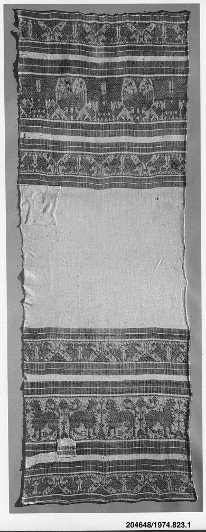 |
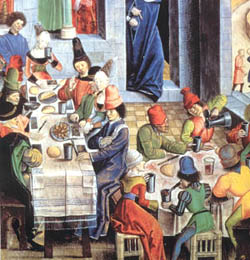 |
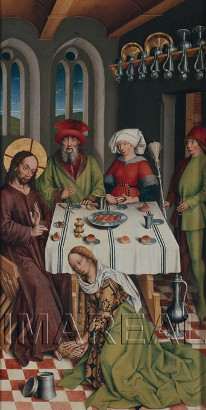 |
|
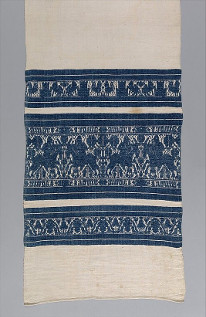 |
Bibliography
Speelberg, F. (2015) Fashion & Virtue: Textile Patterns and the Print Revolution 1520–1620. the Metropolitan Museum of Art.
Thorson, S. (2002) The Compleat Anachronist #114: Perugia Towels

